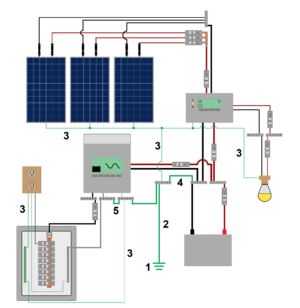Simplified grounding system sizing and selection

(1) Grounding electrode (2) Grounding electrode conductor (GEC) (3) Equipment grounding conductor (EGC) (4) DC system ground (5) AC system ground
Properly grounding an off-grid PV system helps mitigate electrical fires, lighting and electrocution risks to system users. It is simply not possible to simplfy this process very much as designing and installing a proper grounding system is one of the more complicated aspects of off-grid PV system design as there are many different components that are required in order for a grounding system to function properly. What is considered an appropriate design varies regionally based upon not only the electrical code, but also the building, soil type and available materials. Consulting local electricians or PV system installers is recommended.
A few universal notes on grounding electrodes:
- In areas with dry rocky soil adding additional grounding electrodes is a good idea – as long as they are all bonded together - and will only improve the grounding of a system.
- If there is more than one grounding electrode, for example one near a building and another near the PV source, both of them should be connected (bonded) together to avoid any voltage difference between the two electrodes.
- Grounding electrodes should always be installed outside of a structure in order to guide any lightning induced surges away from people.
- Electrodes can be encased in concrete to improve their conductivity. There are even special types of concrete available for this purpose. This is mandated by the electrical code in certain areas.
Contents
Step 1: Determine the type of grounding electrode
Determining the right grounding electrode for a particular project is best done by consulting local electricians. There are some general principles with regard to choosing a grounding electrode:
| Type | Description |
|---|---|
| Ground rod | Ground rods are driven into the ground - typically with a hammer. They are either made from copper or steel coated with copper. They must penetrate 2.5-3 m of ground in order to be able to establish a solid connection with the earth, which can be extremely difficult to achieve in rocky soil. |
| Ground plate | Ground plates are thin large plates with significant surface area that are buried in the ground. They are either made from copper or steel coated with copper. They must be bured at least 75 cm below the earth's surface. A ground plate should have a surface area of at least 1850 cm². Ground plates work well in areas with rocky soil where a driven ground rod is not an option. |
| Building rebar (Ufer) | The rebar of a building, if it is all tied together properly and encased in concrete, can serve as a grounding electrode. There are special connectors that are used to tie a grounding system into the rebar of a building. If a Ufer ground is an option, it will serve as a longer lasting and superior grounding electrode than any other option. |
| Ground ring | A bare (uninsulated) length of wire at least 6 m in length that encircles the building or structure that is at least 4 AWG or 25mm² in size. Must be buried deeper than 75 cm below the earth's surface. |
| Water pipes | If a metallic water pipe exits the building and has more than 3 m in direct contact with the soil, it can serve as a grounding electrode, but another electrode must still be installed (ground rod, ground plate, or Ufer ground). The connection to a water pipe should be made outside of a home - there are special connectors made for this purpose. |
Step 2: Determine the size of the grounding electrode conductor (GEC)
The grounding electrode conductor serves as the main connection between the rest of the system and the grounding electrode(s). Bare copper wire is frequently used for the GEC. The GEC should run directly, uninterrupted by splices or busbars, from the grounding electrode to the grounding busbar.
| Grounding electrode | GEC size |
|---|---|
| Rod/plate | 6 AWG/16 mm² |
| Building rebar (Ufer) | 4 AWG/25 mm² |
| Ground ring | 2 AWG/35 mm² |
Step 3: Determine size of the AC and DC system grounding jumpers
The same size wire used for the GEC should be used for the system grounding jumpers. A ground fault protection device (GFPD) should be considered instead of a simple DC bonding jumper to improve system safety.
Step 4: Determine the size of the equipment grounding conductors (EGCs)
The equipment grounding conductor serves as a path for any fault currents, lightning or static electricity between all of the system equipment. Each circuit in a system will have an EGC that is run with the current-carrying wires (conductors) in order to ensure that all equipment is properly grounded. Each grounding electrode conductor must be sized to the size of the largest overcurrent protection device in the circuit that it will be protecting from the Overcurrent protection device sizing process.
| Largest OCPD size | Minimum AWG size | Minimum mm² size |
|---|---|---|
| 15 | 14 | 2.5 mm² |
| 20 | 12 | 4 mm² |
| 60 | 10 | 6 mm² |
| 100 | 8 | 10 mm² |
| 200 | 6 | 16 mm² |
| 300 | 4 | 25 mm² |